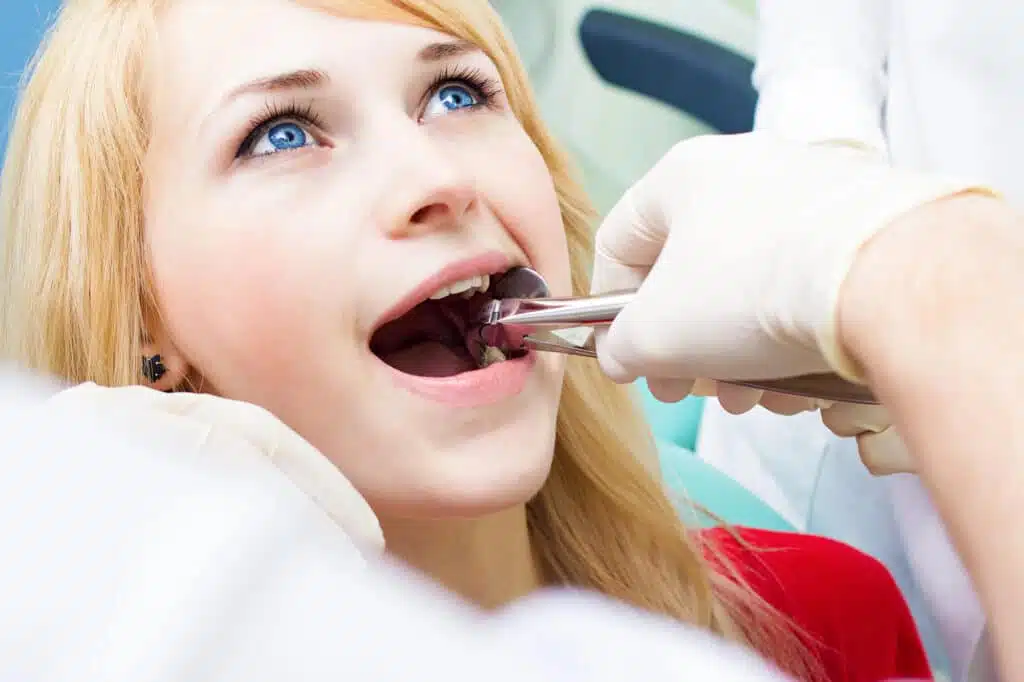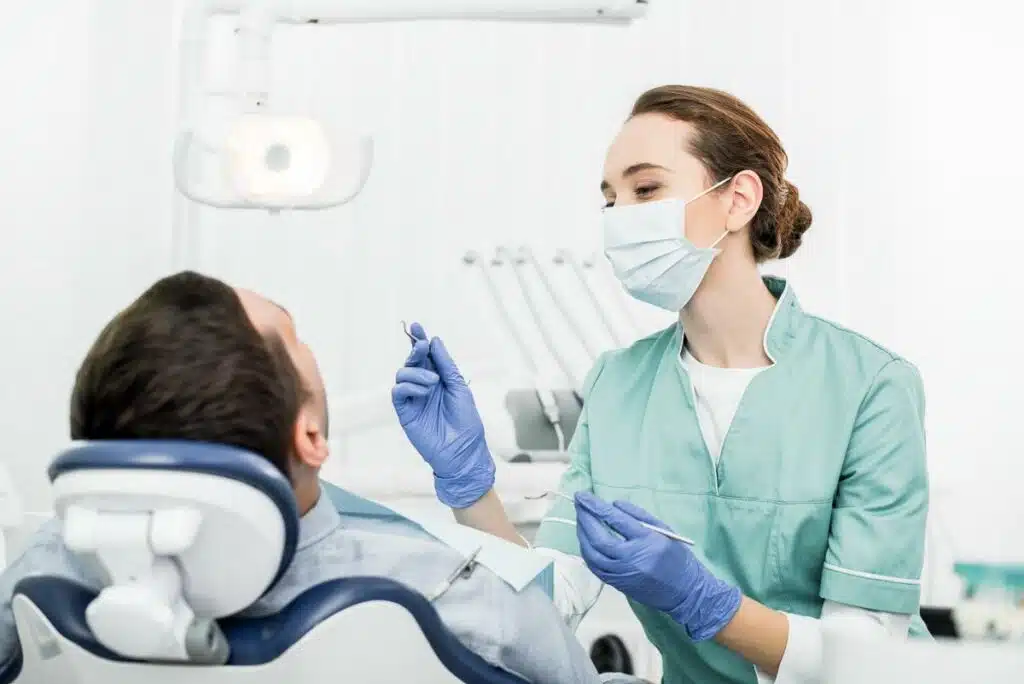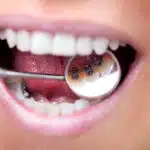Manual toothbrush or electric toothbrush: which is the better choice? Find out the advantages and disadvantages of both options here.
Tooth extraction is a dental procedure in which a tooth is removed from the jaw.
Although the thought of tooth removal may seem unpleasant, it is often a necessary measure to avoid serious complications and improve overall dental health.
In this article you will find out when a tooth extraction is necessary, how the procedure is carried out, what you should consider before and after the treatment and what risks are associated with it.
| Get 150 € discount on your dental correction! |

Book a consultation appointment now at a nearby DrSmile partner practice and find out if teeth straightening with aligners is right for you.
The appointment is completely non-binding and does not involve any costs.
With the code “THATSMILE150” you will receive 150 € discount on the treatment.
When is tooth extraction necessary?
There are many reasons why a tooth extraction may be necessary. Some of the most common situations are:
- Severe caries: If a tooth is severely affected by caries and can no longer be saved by a filling or crown, extraction is often the only option.
- Gum disease: Advanced gum disease (periodontitis) can damage the periodontium to such an extent that the tooth becomes loose and has to be removed.(Find out more about gum correction here).
- Wisdom teeth: Wisdom teeth that erupt crookedly or not at all can cause pain, infections or other dental problems. In such cases, it is often recommended to remove them prophylactically.
- Tooth damage: Heavily damaged teeth due to accidents or injuries that can no longer be repaired must also be extracted.
- Overcrowding: In some cases, especially with orthodontic treatment, teeth need to be removed to make room for the remaining teeth and improve alignment.
- Infections: A tooth infection that does not respond to antibiotics or could spread to the jaw also makes tooth extraction necessary.

The tooth extraction procedure
Tooth extraction can be simple or complicated, depending on the position of the tooth, its shape and the condition of the surrounding tissue.
1. the preparation
Before the procedure begins, your dentist or oral surgeon will carry out a thorough examination.
This often includes an X-ray to assess the exact position of the tooth and the condition of the jawbone.
You should inform the dentist of any medication or health problems, as this may affect the procedure.
2. local anesthesia
In most tooth extractions, a local anesthetic is used to numb the affected area.
This means that you will remain awake during the treatment but will not feel any pain.
Sedation or general anesthesia can also be offered for more complicated procedures or on request.
3. the intervention
- Simple tooth extraction: In a simple extraction, which is usually performed on visible teeth, the dentist uses an instrument called an elevator to loosen the tooth. The tooth is then removed using special forceps. This procedure usually only takes a few minutes.
- Surgical tooth extraction: If the tooth is located under the gum (as with wisdom teeth) or is severely damaged, surgical extraction may be necessary. The gum is carefully cut open and the tooth can be removed in pieces. This method requires more time and skill and is often used in complicated cases.
4. after extraction
After the procedure, the dentist will place a gauze swab on the wound to control the bleeding.
You will need to bite lightly to maintain pressure on the area and encourage blood clotting. In some cases, stitches may also be necessary to close the wound.

What you should consider after tooth extraction
Proper care after a tooth extraction is crucial for a quick recovery and to avoid complications. Here are some tips that can help you:
- Keep calm: After the extraction, you should take it easy for the rest of the day and avoid physical exertion.
- Check the bleeding: It is normal for the wound to bleed slightly for the first few hours after the procedure. Change the gauze swab as necessary, but avoid spitting too often as this can interfere with blood clotting.
- Minimize swelling: To reduce swelling, you can apply a cool pack to the affected area from the outside. Do this every 15 minutes (15 minutes cooling, 15 minutes break).
- Pain management: Mild pain is normal and your dentist may prescribe a painkiller. In most cases, however, over-the-counter painkillers such as ibuprofen or paracetamol are sufficient.
- Eating and drinking: For the first 24 hours, you should eat soft foods such as yogurt, soups or purees. Avoid hot drinks and do not drink through a straw, as the resulting suction can disturb the wound and cause a dry socket.
- Oral hygiene: Brush your teeth as usual, but avoid touching the extraction site. Do not rinse your mouth for the first 24 hours after the procedure. After this period, you can gently rinse with a mild salt water solution to clean the wound.
Possible risks and complications
Although tooth extraction is generally a safe procedure, complications can occur in rare cases:
- Infections: If the wound does not heal properly or germs get in, an infection can occur. Symptoms include fever, severe pain or unpleasant bad breath.
- Dry socket: This is a common complication that occurs when the blood clot protecting the wound dissolves or does not form at all. This can be very painful and requires special treatment by the dentist.
- Injury to adjacent teeth or nerves: In rare cases, damage to adjacent teeth or nerves can occur during extraction. The risk is higher with wisdom tooth extractions, especially if the tooth is close to a nerve canal.

How long does it take to heal after a tooth extraction?
Healing after a tooth extraction takes place in several phases. In the first few days, a blood clot forms in the tooth cavity and the surrounding tissue begins to heal.
After about a week, the gums begin to regenerate and the wound becomes smaller.
In the case of uncomplicated extractions, complete healing takes about two to three weeks.
Surgical procedures can take longer, especially if the jawbone is affected.
Conclusion on the subject of tooth extraction / tooth extraction
Tooth extraction may seem unsettling at first, but it is a routine and safe procedure that is necessary in many cases to maintain dental health.
By preparing well for the procedure and following your dentist’s instructions, you can promote a quick and uncomplicated recovery. B
f you have any questions or concerns, you should always contact your dentist to ensure that you are well informed and can prepare for the procedure in the best possible way.
In this article, you’ll learn everything you need to know to make an informed decision about which toothbrush is the better choice for your dental care.
| Get 150 € discount on your dental correction! |

Book a consultation appointment now at a nearby DrSmile partner practice and find out if teeth straightening with aligners is right for you.
The appointment is completely non-binding and does not involve any costs.
With the code “THATSMILE150” you will receive 150 € discount on the treatment.
FAQs on the topic of tooth extraction / tooth extraction
Here we answer a few of the most frequently asked questions about tooth extraction.
1 When is tooth extraction necessary?
A tooth extraction is performed when a tooth is so badly damaged or infected that it can no longer be saved.
Common causes are severe tooth decay, gum disease (periodontitis), broken teeth, superfluous wisdom teeth or tooth overcrowding.
In some cases, a tooth is also removed to make room for orthodontic treatment.
2 How does a tooth extraction work?
The procedure begins with a thorough examination and an X-ray to determine the position of the tooth.
The area is then locally anesthetized so that you do not feel any pain during the extraction.
In a simple extraction, the tooth is loosened with a special tool and pulled out.
In a surgical extraction, such as for wisdom teeth, the gum is cut open and the tooth can be removed in several pieces.
3. is tooth extraction painful?
You will not feel any pain during the tooth extraction itself, as the affected area is locally anesthetized.
However, mild to moderate pain may occur after the procedure. This can usually be treated well with over-the-counter painkillers such as ibuprofen or paracetamol.
In rare cases, the dentist will prescribe stronger painkillers.
4 How long does it take to recover from a tooth extraction?
The recovery time varies depending on the type of extraction. In the first few days after the procedure, a blood clot forms in the tooth cavity and the gums begin to heal.
For simple tooth extractions, healing takes about a week. For more complex surgical procedures, especially wisdom tooth extractions, complete healing can take two to three weeks.
5 What should be considered after a tooth extraction?
After tooth extraction, you should rest and avoid physical exertion. Cooling the affected area helps to reduce swelling.
It is important not to disturb the blood clot in the wound by spitting or drinking with a straw.
For the first 24 hours, you should eat soft foods and avoid hot drinks. Also avoid smoking, as this can delay healing.
6 What are the most common complications after tooth extraction?
The most common complication after tooth extraction is the so-called dry socket, in which the blood clot in the tooth cavity is missing or dissolves.
This can cause severe pain and requires special treatment. Other possible complications include infection or bleeding that lasts longer than usual.
If a fever occurs or the pain is unusually severe, a visit to the dentist is advisable.
7 How can you prepare for a tooth extraction?
Before the tooth extraction, you should inform the dentist about all medications and health problems, as these can affect the procedure.
It may also be useful to have a companion with you on the day of the procedure, especially if sedation or general anesthesia is used.
Plan sufficient rest after the procedure to support healing.
8 What can I eat after the extraction?
In the first 24 hours after tooth extraction, you should only eat soft foods such as yogurt, soups or purees.
Avoid spicy, crunchy or hot food as it can irritate the wound. Cold or lukewarm is better for the first few days.
As soon as the healing progresses, you can gradually return to normal food.
9. can you work or do sports after a tooth extraction?
After a simple tooth extraction, you can usually return to work the next day, depending on your well-being.
For more complicated procedures such as wisdom tooth removal, it may be advisable to take a day or two off.
Sports activities should be avoided for at least 48 hours, as physical exertion can disrupt blood clotting and lead to secondary bleeding.
10 When should I visit the dentist after the extraction?
You should see your dentist if you experience any unusual symptoms after tooth extraction.
These include severe pain that cannot be relieved with painkillers, persistent bleeding, swelling, fever or an unpleasant odor from the wound.
These symptoms could indicate an infection or a dry alveolus and require prompt treatment.



Leave a Reply